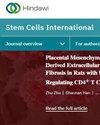通过大量和单细胞rna测序分析揭示骨肉瘤癌症干细胞的细胞特性
IF 3.8
3区 医学
Q2 CELL & TISSUE ENGINEERING
引用次数: 0
摘要
骨肉瘤(OS)是一种典型的肉瘤,主要影响青少年。肿瘤干细胞(CSC)行为的标志遍及OS,总是预示着不良预后。然而,OS转移背后的复杂性仍未被完全理解。随着科学研究的前沿不断推进,包括大量测序和单细胞测序(scRNA),生物信息学领域发现了多方面的用途。在这项研究中,我们将scRNA和批量测序与临床元数据相结合,以挖掘控制OS转移倾向的潜在分子底物。我们的scRNA分析表明,细胞干细胞相关通路可能在肿瘤转移中发挥重要作用。随后,对大量自主测序数据集进行加权基因共表达网络分析(WGCNA),以识别10个基因簇。通过对临床数据的分析,我们确定了两个中心基因,HDAC2和HSPA4,它们与癌细胞的干细胞性密切相关。此外,我们进行了transwell实验来验证miR-1-3p、HDAC2和HSPA4在OS细胞中对转移行为的调节。值得注意的是,我们的研究通过对OS患者获得的肿瘤组织进行免疫组织化学(IHC)分析而得到加强,从而强调了我们实验努力的临床意义。值得注意的是,我们揭示了miR-1-3p对HDAC2和HSPA4的抑制作用,与标准队列相比,miRTarBase在肿瘤组织中的表达较低。从产生有效治疗的治疗应用研究(TARGET)项目(https://ocg.cancer.gov/programs/target)中收集的见解进一步增强了已确定的中心基因的临床意义。总之,我们的研究结果强调了细胞连接在控制OS干细胞性和转移中的重要作用,这一点通过单细胞测序和批量测序分析的整合得到了强调。此外,我们的基础实验确定了与转移行为密切相关的三个中心分子。我们的发现为临床治疗和对OS的基本理解提供了新的见解。本文章由计算机程序翻译,如有差异,请以英文原文为准。
Unveiling Cellular Traits of Osteosarcoma Cancer Stem Cells via Bulk and Single-Cell RNA-Sequencing Analysis
Osteosarcoma (OS) is a prototypical sarcoma, predominantly affecting adolescents. The hallmark of cancer stem cell (CSC) behavior pervades OS, invariably signifying an unfavorable prognosis. However, the intricacies underlying OS metastasis remain incompletely comprehended. As the frontiers of the scientific investigation push forward, encompassing both bulk sequencing and single-cell sequencing (scRNA), the domain of bioinformatics finds multifaceted utility. In this study, we combined scRNA and bulk sequencing with the clinical metadata to excavate the latent molecular substrates governing metastatic propensities within OS. Our scRNA analysis indicated that cell-stemness-related pathways might play vital roles in OS metastasis. Subsequently, an autonomous reservoir of bulk sequencing data set was subjected to weighted gene co-expression network analysis (WGCNA) to identify 10 gene clusters. After analyzing the clinical data, we were able to identify two hub genes, HDAC2 and HSPA4, which are strongly linked to the cancer cell stemness. Moreover, we performed transwell assays to validate the regulation of metastatic behaviors by miR-1-3p, HDAC2, and HSPA4 in OS cells. Significantly, our study was fortified by immunohistochemistry (IHC) analyses performed on tumor tissues acquired from OS patients, thereby accentuating the clinical import of our experimental endeavor. Notably, we unveiled the suppressive influence of miR-1-3p on both HDAC2 and HSPA4, with miRTarBase substantiating lower expression in tumor tissue relative to the normative cohort. Insights gleaned from the Therapeutically Applicable Research to Generate Effective Treatments (TARGET) program (https://ocg.cancer.gov/programs/target) further augmented the clinical significance of the identified hub genes. In conclusion, our findings highlight the significant role of cell junctions in governing OS stemness and metastasis, underscored by the integration of single-cell sequencing and bulk-sequencing analyses. Moreover, our foundational experiments identified three hub molecules closely associated with the metastatic behaviors. Our findings provide novel insights into the clinical treatment and fundamental understanding of OS.
求助全文
通过发布文献求助,成功后即可免费获取论文全文。
去求助
来源期刊

Stem Cells International
CELL & TISSUE ENGINEERING-
CiteScore
8.10
自引率
2.30%
发文量
188
审稿时长
18 weeks
期刊介绍:
Stem Cells International is a peer-reviewed, Open Access journal that publishes original research articles, review articles, and clinical studies in all areas of stem cell biology and applications. The journal will consider basic, translational, and clinical research, including animal models and clinical trials.
Topics covered include, but are not limited to: embryonic stem cells; induced pluripotent stem cells; tissue-specific stem cells; stem cell differentiation; genetics and epigenetics; cancer stem cells; stem cell technologies; ethical, legal, and social issues.
 求助内容:
求助内容: 应助结果提醒方式:
应助结果提醒方式:


